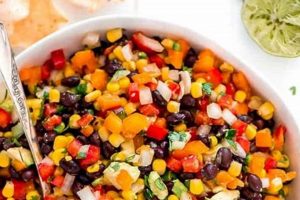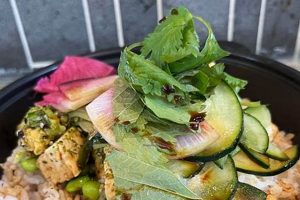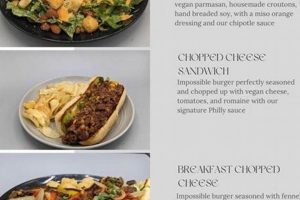Coloring derived solely from plant-based sources, used to impart hue to foodstuffs, represents a significant segment within the broader food additive industry. Examples include beet juice for red shades, spirulina for blue, and turmeric for yellow, providing alternatives to synthetic dyes or those derived from animal products.
The importance of these colorants lies in their appeal to consumers seeking ethically sourced and natural ingredients. Benefits encompass aligning with dietary restrictions and promoting cleaner labeling practices. Historically, plant-derived colorants were the primary method of imparting color to foods before the advent of synthetic alternatives. The resurgence in demand reflects evolving consumer preferences.
The subsequent sections will explore various aspects of these plant-derived additives, including their sources, extraction methods, stability, and applications in different food product categories. Furthermore, regulatory considerations and market trends pertaining to these coloring agents will be analyzed.
Using Plant-Derived Food Colorants Effectively
The following tips offer guidance for maximizing the effectiveness and appeal of plant-derived food colorants in various applications.
Tip 1: Consider the pH: Many plant-derived colorants are pH-sensitive. Anthocyanins, for example, appear red in acidic conditions and blue in alkaline conditions. Adjusting the pH of the food matrix can influence the final color outcome.
Tip 2: Account for Heat Sensitivity: Certain natural colorants degrade under high temperatures. Introduce these colorants during the later stages of processing to minimize heat exposure and preserve color intensity.
Tip 3: Understand Light Stability: Exposure to light can cause fading in some natural colorants. Packaging that blocks UV light can significantly extend the shelf life and maintain the desired color of the product.
Tip 4: Optimize Concentration: Excessive concentration of plant-derived colorants can impart unwanted flavors. Conduct thorough testing to determine the minimum effective concentration needed to achieve the desired color intensity.
Tip 5: Explore Color Blending: Combining different plant-derived colorants can create a wider spectrum of hues. Experiment with blends to achieve specific shades that are otherwise unattainable with single colorants.
Tip 6: Evaluate Interactions with Ingredients: Certain ingredients can interact with plant-derived colorants, potentially altering their stability or color expression. Thoroughly assess compatibility with all other ingredients in the formulation.
Tip 7: Check Regulatory Compliance: Ensure that the plant-derived colorant used is approved for use in the specific application and region. Regulations regarding food additives vary significantly across different jurisdictions.
These tips are intended to facilitate informed and effective utilization of plant-derived colorants, leading to products that are both visually appealing and aligned with consumer preferences for natural ingredients.
The article will now proceed to delve into the practical applications of these colorants within specific food industry sectors.
1. Source Identification
Source Identification is the foundational aspect of determining if a colorant aligns with “vegan food coloring” standards. It directly impacts product labeling, consumer trust, and ethical considerations. A misidentification of the source can lead to the unintentional inclusion of animal-derived components, rendering the product non-compliant with vegan principles and potentially misleading consumers. For instance, carmine, a red pigment derived from insects, is sometimes inadvertently included in products labeled as natural; accurate Source Identification prevents this.
The methods employed for Source Identification can range from documentation review and supplier audits to laboratory testing, including DNA analysis and chromatography. These techniques are essential for verifying claims of plant-based origin. For example, if a blue coloring is identified as derived from spirulina, a blue-green algae, documentation should confirm the source and processing methods exclude animal-derived inputs. Accurate identification also impacts regulatory compliance, as specific colorants might have limitations or require disclosures based on their source.
In conclusion, Source Identification is not merely a preliminary step but a continuous verification process crucial for maintaining the integrity of “vegan food coloring.” The accuracy of this process directly affects product legality, consumer confidence, and alignment with ethical standards. Challenges exist in tracing complex supply chains, but rigorous source verification is necessary for maintaining the standards associated with plant-based ingredients.
2. Extraction Methods
Extraction methods are intrinsically linked to the integrity of “vegan food coloring,” influencing both the purity and ethical compliance of the final product. The chosen extraction technique directly affects whether a plant-derived colorant remains free from animal-derived contaminants or processing aids. For instance, using gelatin or other animal-based clarifying agents during extraction would invalidate the colorant’s vegan status, irrespective of the original plant source. Therefore, meticulous attention to extraction processes is paramount to maintaining the integrity of “vegan food coloring.”
Aqueous extraction, solvent extraction, and supercritical fluid extraction represent common techniques. Aqueous extraction employs water as a solvent, often coupled with heating or enzymatic pre-treatment, minimizing the risk of non-vegan contamination. Solvent extraction utilizes organic solvents to isolate the colorant, necessitating careful selection of solvents guaranteed to be free from animal-derived substances and ensuring their complete removal post-extraction. Supercritical fluid extraction, often using carbon dioxide, offers a cleaner alternative due to its non-toxic nature and ease of removal. The selection of an extraction method must consider efficiency, environmental impact, and compatibility with vegan principles.
In conclusion, the success of producing authentic “vegan food coloring” hinges on employing extraction methods that avoid animal-derived materials throughout the process. The choice of extraction technique is a critical decision impacting not only the colorant’s purity but also its compliance with ethical and regulatory standards. Continuous evaluation and optimization of extraction processes are vital for ensuring the accessibility and reliability of truly vegan colorants.
3. Color Stability
Color Stability represents a critical attribute of “vegan food coloring” due to its direct influence on the visual appeal and marketability of the final food product. The inherent sensitivity of many plant-derived pigments to factors such as pH, temperature, light, and oxidation can lead to color degradation over time, resulting in undesirable shifts in hue or intensity. This instability not only affects the aesthetic qualities but also can be misconstrued by consumers as an indicator of product spoilage or compromised quality, diminishing trust in the brand.
The selection of a “vegan food coloring” agent must therefore consider the specific processing and storage conditions the food product will endure. For instance, anthocyanins, responsible for red and purple hues, are susceptible to degradation at high temperatures commonly encountered in baking or canning processes. Alternatively, betalains, derived from beetroot, exhibit good stability at low pH but are prone to fading under prolonged exposure to light. Addressing these challenges involves encapsulation techniques, the addition of stabilizers like ascorbic acid, or the use of light-protective packaging. Failure to manage stability leads to products with faded or altered colors, negating the visual appeal that the colorant was intended to provide, thus undermining the economic value of using “vegan food coloring.”
In conclusion, the preservation of color integrity is paramount for the successful implementation of “vegan food coloring.” Thorough evaluation of color stability under relevant environmental conditions, coupled with appropriate stabilization strategies, is essential to ensure that the final product retains its desired visual characteristics throughout its shelf life. Overcoming these challenges contributes to the viability and consumer acceptance of food products incorporating plant-derived coloring agents.
4. Application Versatility
Application Versatility, when considered in the context of “vegan food coloring,” defines the range of food products and processing conditions under which a specific colorant can be effectively utilized. This characteristic is critical for food manufacturers aiming to create a diverse portfolio of plant-based offerings without compromising visual appeal or product stability. The broader the application versatility of a “vegan food coloring,” the more adaptable it is for use across varied product lines, reducing the need for multiple specialized colorants.
- Beverage Compatibility
The behavior of “vegan food coloring” in beverages is particularly important due to the wide variety of pH levels, clarity requirements, and processing methods. Some natural colorants may exhibit precipitation, fading, or unwanted color shifts in acidic or carbonated environments. For instance, anthocyanins, though vibrant in certain conditions, may require stabilization techniques to maintain their color integrity in citrus-based beverages. Colorants that demonstrate high solubility, pH stability, and resistance to light degradation are highly valued for beverage applications.
- Baking and Confectionery Suitability
High-temperature processing, typical in baking and confectionery, presents unique challenges for “vegan food coloring.” Many natural pigments degrade under heat, leading to loss of color or undesirable browning. Colorants such as caramel color, which is heat-stable and can provide a range of brown hues, are often preferred for baked goods. In contrast, sensitive pigments like betalains may require encapsulation or post-baking application to preserve their color in thermally processed items. The suitability of a colorant for baking and confectionery hinges on its thermal stability and compatibility with other ingredients like sugars and starches.
- Dairy and Dairy Alternative Applications
“Vegan food coloring” must also perform effectively in dairy and dairy alternative matrices, which vary significantly in composition and processing. Factors such as fat content, protein levels, and homogenization processes can influence color dispersion and stability. For example, beta-carotene, a fat-soluble pigment, is readily used in dairy and plant-based milk alternatives, providing a yellow-orange hue. Ensuring uniform color distribution and preventing color bleeding are crucial in these applications, particularly in products with distinct layers or inclusions.
- Processed Foods Integration
Processed foods, including sauces, snacks, and prepared meals, pose varied challenges for “vegan food coloring.” These products often undergo complex processing steps, such as retort sterilization, extrusion, or dehydration, which can impact color stability. Additionally, interactions with other ingredients, such as preservatives, salts, and acids, may affect the colorant’s performance. Colorants that exhibit broad compatibility with various processing methods and food additives are essential for ensuring consistent color quality in processed food applications.
In summary, Application Versatility is a multifaceted attribute that determines the usability of “vegan food coloring” across diverse food sectors. By carefully evaluating a colorant’s performance under different processing conditions and within various food matrices, manufacturers can optimize their product formulations and ensure consistent visual appeal. The selection of colorants with broad application versatility not only simplifies product development but also enhances the overall marketability and consumer acceptance of vegan food products.
5. Regulatory Status
The regulatory status of “vegan food coloring” is intrinsically linked to its market access, consumer safety, and legal compliance. Food color additives, irrespective of their origin, are subject to rigorous evaluation and approval processes by regulatory bodies worldwide, such as the U.S. Food and Drug Administration (FDA) and the European Food Safety Authority (EFSA). Failure to comply with these regulations can result in product recalls, legal penalties, and significant reputational damage. For instance, a naturally derived red colorant not approved for use in a specific food category could lead to the product’s removal from store shelves, regardless of its vegan status.
The regulatory framework governing “vegan food coloring” generally focuses on aspects such as chemical identity, purity specifications, toxicological assessments, and permitted uses. Regulations may also dictate maximum usage levels and labeling requirements to inform consumers about the presence of color additives in food products. One example is the regulation of spirulina extract, a blue colorant, where the FDA has specified the types of food products in which it can be used and the maximum concentration allowed. Understanding these detailed regulations is crucial for manufacturers to ensure that their use of “vegan food coloring” aligns with legal standards.
In conclusion, the regulatory status of “vegan food coloring” is not merely a bureaucratic formality but a fundamental determinant of its viability. Compliance with applicable regulations is essential for ensuring product safety, maintaining consumer trust, and avoiding legal repercussions. Due diligence in navigating the regulatory landscape is therefore a critical aspect of product development and commercialization in the “vegan food coloring” sector. Moreover, ongoing monitoring of regulatory updates and amendments is necessary to adapt to evolving legal requirements, thereby ensuring sustained market access.
Frequently Asked Questions Regarding Vegan Food Coloring
The following addresses common inquiries about the nature, sourcing, and application of plant-derived coloring agents.
Question 1: What constitutes “vegan food coloring” and how does it differ from other food colorants?
The term refers exclusively to coloring agents derived from plant, fungal, or microbial sources that are processed without the use of animal products or by-products. This contrasts with colorants derived from insects (e.g., carmine) or processed using animal-derived ingredients (e.g., bone char). Purity of origin and processing are defining factors.
Question 2: How is the vegan status of a food colorant verified?
Verification involves a multi-faceted approach. Documentation from suppliers detailing the origin and processing of the colorant is essential. Audits of manufacturing facilities may be conducted to ensure compliance with vegan standards. Laboratory testing can confirm the absence of animal-derived contaminants.
Question 3: What are common plant-based sources for “vegan food coloring”?
Common sources include beets (betalains for red), spirulina (phycocyanin for blue), turmeric (curcuminoids for yellow), carrots (carotenoids for orange), and chlorophyll from various green plants. The specific plant source dictates the resulting color and its stability characteristics.
Question 4: Are “vegan food coloring” agents inherently safer than synthetic colorants?
Safety depends on the specific colorant and its intended use, not solely on its natural origin. All food color additives, including those derived from plants, must undergo rigorous safety assessments by regulatory bodies. While some natural colorants may possess beneficial antioxidant properties, others may have limitations regarding acceptable daily intake.
Question 5: How does the stability of “vegan food coloring” compare to synthetic alternatives?
Generally, plant-derived colorants are more susceptible to degradation from factors such as heat, light, and pH changes compared to certain synthetic colorants. Strategies to improve stability include encapsulation, the addition of stabilizers, and optimization of the food product’s formulation. Specific stability characteristics vary significantly depending on the colorant’s chemical composition.
Question 6: What are the regulatory requirements for using “vegan food coloring” in food products?
Regulatory requirements vary by jurisdiction. In most regions, plant-derived colorants are subject to pre-market approval or notification processes. Regulations may specify permitted uses, maximum usage levels, and labeling requirements. Compliance with these regulations is essential for legal market access.
In summation, selecting and utilizing “vegan food coloring” requires a thorough understanding of its origin, stability, safety, and regulatory status. Informed decision-making ensures both product integrity and regulatory compliance.
The discussion now proceeds to explore future trends in the realm of plant-derived food colorants.
Conclusion
The preceding discussion has illuminated the multifaceted nature of “vegan food coloring,” emphasizing its definition, sourcing, extraction, stability, application, and regulatory standing. The necessity for meticulous source verification, adherence to ethical extraction methods, and thorough stability assessments has been underscored. Furthermore, the variable application versatility and the imperative of regulatory compliance have been detailed, providing a comprehensive overview of the key considerations for utilizing plant-derived colorants in the food industry.
The continued advancement and adoption of “vegan food coloring” depend on sustained research, technological innovation, and a commitment to transparent labeling practices. The food industry is urged to prioritize diligent sourcing, rigorous testing, and proactive engagement with regulatory bodies to ensure the integrity and safety of plant-derived coloring agents. Such efforts will foster consumer trust and facilitate the ethical evolution of food production.







